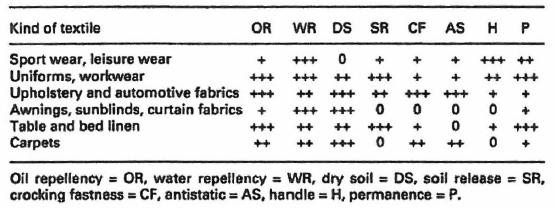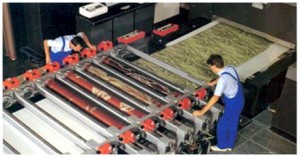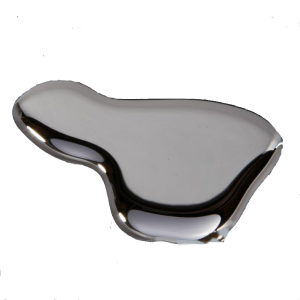Technical background of water and soil repellent finishing on textiles, and alternatives for the future
In a previous article, “Greenpeace puts pressure on outdoor brands to phase out hazardous chemistry”, we have discussed reports of Greenpeace and the German Umweltbundesamt (UBA) on hazardous fluorocarbons found in outdoor articles, and the progress of the ZDHC brands towards elimination of such hazardous chemicals.
In this article we discuss the technical and scientific background of water and soil repellent finishing on textiles, and will look into options for future, more sustainable technologies and chemistries.
State of the art in water and soil repellency, and what the consumer really needs
For water & soil repellent finishing on textiles various chemical solutions can be applied, of which perfluorocarbon (PFC) chemistry has become state of the art in performance. But this chemical substance class has been put under critical observation in regard to their toxicity and persistence in the environment. Certain types of PFCs, long chain PFCs such as PFOA (perfluorooctanoic acid), have been put on the black list by ZDHC brands and Greenpeace, while there are still different opinions to what extent and how fast this should be implemented.
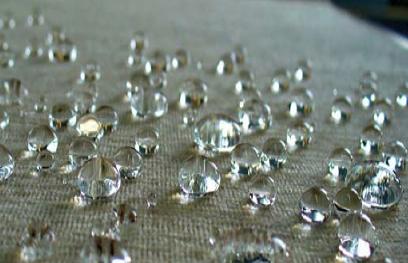 For a judgment for the technology, one has to differentiate between water and soil/oil repellency.For water repellency good alternatives to long-chain fluorocarbons are available, as discussed further in the context.
For a judgment for the technology, one has to differentiate between water and soil/oil repellency.For water repellency good alternatives to long-chain fluorocarbons are available, as discussed further in the context.
On the other hand, for oil, blood and soil repellency, no commercial product is known yet to match the performance of long-chain fluorocarbons. This fact is even acknowledged by Greenpeace in their study[1].
The following table[2] shows the technical requirements, differentiated by textile article class.
It is obvious from the table that oil repellency is important for uniforms, workwear, upholstery, automotive fabrics, table and bed linens. However, from the article assessment it is not so obvious why it should be a technical criteria for outdoor (sportswear and leisure wear segment).
While it is generally accepted that alternative technologies have limitations in regard to their performance, however the question is why does an outdoor article have to have the same soil / oil / blood repellency as the uniform of a combat soldier, or a surgeon in the hospital? Does the average consumer who typically uses outdoor articles for casual sport activities really need these features?
As Greenpeace rightly states “For the consumer, oil repellency is often not a relevant criterion”. For the consumer of outdoor apparel it is optimal moisture protection what matters most. Greenpeace calls upon the consumer to reconsider such issues in their buying decision [1].
It is unfortunate that this issue has not been addressed by the ZHDC brands so far.
While there may be technically sound alternatives for the outdoor segment for water repellency, and soil/oil repellency is not really required for outdoor, but for other articles classes the issue of soil/oil repellency alternatives should be nevertheless examined.
Understanding the effect of water & soil repellency
In theory, when the surface tension of the liquid is lower than the surface free energy of the solid, the liquid will spontaneously wet the solid.
The crucial technical parameters are the contact angle of a liquid droplet on a solid surface, which is largely determined by adhesion forces inside the liquid and towards to solid surface. The adhesion forces can be linked with the surface free energies, and the critical surface tension.
Contact angles and critical surface tensions for various materials are available in the scientific literature (e.g. Arkles[3]). For a better understanding, the surface free energies, respectively critical surface tension, of various polymer fibres and surface tensions of liquids are shown in the following table[4]
| containing PFC |
Critical surface tension[5],[6](surface free energy) Surface tension (liq) in mJ/m2 |
Repellency Effect |
||
| water @25°C | 72 | >45hydrophilic |
less repellent more repellent |
|
| cellulose cotton[7] | 64-68 | |||
| polyamides (nylon 6.6, nylon 6) | 42-46 | |||
| polyester (PET) | 39-43 | |||
| cellulose viscose[7] | 33 |
<35: hydrophobic water repellent |
||
| mineral oil | 31 | |||
| polyethylene (hydrocarbone) | 31 | |||
| water containing 0.5% detergent | 27-33 | |||
| water repellent finishing | 24-30 | |||
| paraffine wax | 25 | |||
| polysiloxane, silicon oil | 23-24 | |||
| Teflon (perfluorinated polyethylene) | X | 18 |
<20 oleophobic oil repellent |
|
| oil repellent finishing | X | 10-20 | ||
| heptadecafluorodecyltrichlorosilane | X | 12 | ||
| closest packed CF3 surface | X | 6 | ||
Liquids with a surface tension below the critical surface tension of the substrate will wet the substrate. Textile wetting agents and detergents lower the surface tension of water considerably (from 73 down to 27-33). But it is still considerably above the surface tension of perfluorinated materials such as Teflon (18). Therefore, a droplet of water containing detergents will not wet a layer of perfluorinated material.
The characterization of a surface as hydrophilic or hydrophobic can be associated with water contact angles: On smooth surfaces an “intrinsic hydrophobicity” with maximum water contact angles of 120°, while ultra-hydrophobic surfaces with considerably higher contact angles can be designed through additional surface roughness[8]. A very famous example in nature is the Lotus leaf with contact angles up to 170° due to the structure of the surface. Such surfaces even exhibit self-cleaning properties.
Highest contact angles – perfect hydrophobic surface of 180° – can be achieved by a hydrolytic decomposition of methylchlorosilanes as microfibrillar structures[3].
Embedded is a video to illustrate how the Lotus effect with self cleaning works on micro structured surfaces
The chemistry for water & soil repellent finishing
Fluorocarbon (PFC) chemistry
As discussed above, the finishing chemicals with the best performance are perfluorocarbons (PFCs) PFC polymers are commonly used for water and soil repellent finish. A typical chemical structure of a PFC polymer is shown in the following chart.

The PFC radicals contains m carbon atoms carrying fluoro atoms, in total m+2 carbon atoms. In the chart, when m is 8, the PFC moiety is the notorious PFOA (perfluorooctanoic acid) which is a hazardous chemical of high environmental concern.
Alternative, PFOA-free technologies for water and soil repellency
Outdoor articles with water repellency properties can be made by using alternative technologies, to avoid the use of the hazardous PFOA.
A comprehensive study has already been published by the Danish Ministry of the Environment in 2005[9].
In membranes, alternatives to fluorocarbon membranes can be polyester or polyurethane membranes.
In coatings, a variety of alternative substance classes is available.
In short, such suitable alternative technologies include
- Short-chain fluoro alkyl compounds, such as C6 PFCs
- Silicones
- Paraffines
- Stearic acid-melamines
- Dendrimers
- Micro-scaled surfaces
Short-chain fluoro alkyl compounds
Short-chain fluoro alkyl compounds, such as C6-fluorocarbon chemistry, are considered as less hazardous although they are persistent as well, and they re not entirely examined in regard to their environmental impact.
An example is the NanoSphere technology promoted by Clariant and Schoeller. According to the suppliers[10]
“The new NanoSphere® transfers the natural non-stick and cleaning effect on the basis of modern nanotechnology to the surface of the fabric and achieves top results regarding oil and water repellency, abrasion resistance and washing permanence. Due to the use of the most modern C6 fluorocarbon technology, the new NanoSphere® is also free of PFOA and PFOS”
The promoters claim [10] self cleaning properties „Water or substances such as oil or ketchup simply run off the NanoSphere® surface, any residue can easily be rinsed off with a little water.”
The nanoparticles in the finished fabrics are designed in way to form a fine structure on the textile surface.
Another approach is to optimize PFC systems. In the so –called Bionic Finish by Rudolf, a combination of hydrocarbons and PFCs are applied, reducing the persistent PFC content by 75%.
Silicones, typically dimethylsiloxanes, exhibit high water repellency, softening and smoothing of the fabrics, but they have comparably low durability to laundering. Also, they do not provide repellency to oil.

Silicones form a cross-linked three-dimensional network around the fibre. The outward oriented methyl groups provide the desired water repellency effect.
Silicons are the most versatile polymer known. They are derived from the most abundant raw material on earth, sand. Silicone is a generic term that refers to a class of man made polymers based on a framework of alternating silicon and oxygen atoms, with organic substituents, such as methyl groups, attached to the silicon atoms.
Silicone water repellents or waterproofing agents are applied in two forms:
- Polydimethylsiloxanes[2] (as illustrated in the structure above), as elastomeric coatings that adhere to the substrate and cure to form a flexible, protective membrane.
- Penetrating water-repellent chemicals – reactive silanes and siloxane resins with crosslinkable side chains[3]. These materials have smaller molecular structures, which enable them to penetrate deeply into the substrate, where they chemically bond with it.
Good summaries on silicone chemistry and the application in textile finishing and other industries are available in the literature[11],[12].
And there is potential for improvements and design of new functions. The variety of silicone chemistry, by modification of the substituents, opens a toolbox for chemists to design new properties.
Functionalisation of textiles with nanosol coatings by application of sol-gel technologies[13],[14] are promising to achieve new materials for soil and water repellent finishing on textiles, however also here it is acknowledged that fluorinated compounds give the best effect for soil and oil repellency.
Very low critical surface tension value are obtained by a combination of PFC and silan chemistry[3].
Paraffines, typically through their fatty acid aluminium or zirconium salts, are one of the oldest water repellents. They do repell water, but they do not repel oil. Paraffines are cheap, however, the have the disadvantages of poor fastness to laundry and dry cleaning, and they increase flammability.
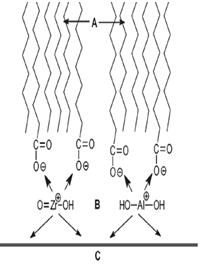
Stearic acid-melamines react with cellulose through N-methylol groups, thus providing durability during laundry, however, itself being a potential source to release formaldehyde, it is not really a sustainable alternative. Disadvantages are reduced teat strength and shade changes in dyed fabrics.

Dendrimers[15] are highly branched molecules. An example for a dendrimer is the Bionic-Finish Eco[16] by Rudolf, providing a “intelligent self-organisation” for optimum water-repellent effects, according to the supplier. Dendrimers, free of PFC, can be used.

The following table summarizes the options for water & oil repellent finishing.
Comparison of water & soil repellent finishing
The vision
In nature, plants and animals can achieve water and soil repellency effects without any fluorocarbons[17], by intelligently designing the surface structures. In a similar way animals create also colour effects, a model which we already discussed in the context of colouration without dyes[18].
Nature can be considered as a model for nano-technological effects[19] – the so called Lotus effect is legendary in the context.

The challenge for material engineers, chemists as well as physicists, is to design a micro-structure on the fibre surface to mimic nature, while avoiding potentially hazardous chemistry.
Theoretically the effects can be achieved by proper design of the surface structure, while avoiding any hazardous chemistry. Nature does not need fluorocarbons to create the Lotus effect.
Research on superhydrophobicity is carried out all over the world. Many publications have appeared focused at superhydrophobic effects. Many are still based on fluorocarbon chemistry, but not all. For example, interesting research is made in the design of nano-scaled surfaces to achieve superhydrophicity, without the use of fluorocarbon chemistry, based on micro-structured inorganic Zr- and Al-oxide layers[8]. Unfortunately, it seems, expensive equipment for making the nano-scaled designs would be required, and these alternative non- fluorocarbon chemistries have to be judged also in the view of economical feasibility.
In future articles in this blog the editor and additional experts will discuss the latest developments in science and technology to address these issues.
[1] Greenpeace: “Chemistry for any weather”
[2] Schindler,W. & Hauser, P. “Chemical Finishing of Textiles”, Woodhead Publishing, 2004
[3] Arkles,B., Paint & Coatings magazine 2006, The role of polarity in the structure of silanes
[4] NearChimica: Water and Soil Repellent Finishing
[5] The critical surface tension, respectively the surface energies of liquids are determined by measuring the surface tension with a duNouy ring,
[7] Gardner,D.J. et al. J. Adhesion Science Technology 22 (2008), 545 – data vary depending on source, measurement techniques and fibre quality. Crystallinity is a very important influencer.
[8] Duparre´,A., et al. „Lotus effect, kohlrabi leaf, motheye? Nanostructure design for ultra-hydrophiobic surfaces“, Fraunhofer IOF Jahresbericht 2004
[9] Poulsen,P.B., Jensen,A.A., Danish Ministry of the Environment: “More environmentally friendly alternatives to PFOS-compounds and PFOA”, 2005
[11] Noll,W.: Chemistry and Technology of Silicones, Elsevier, 1968, chapter 10.8
[12] O´Lenick,A.J.: Basic Silicone Chemistry – A Review, 1999,
[13] Mahltig,B., Haufe,H., Blöttcher,H., Journal of Materials Chemistry 14 (2005), 4385-4398 Functionalisation of textiles by sol-gel technologies
[14] Simoncic,B., et al. : „Sol-Gel Technology for Chemical Modification of Textiles“, University of Twente, ADVANBIOTEX WORKSHOP: Surface Modification Systems for Creating Stimuli Responsiveness of Textiles
[16] Bionic Finish Eco

